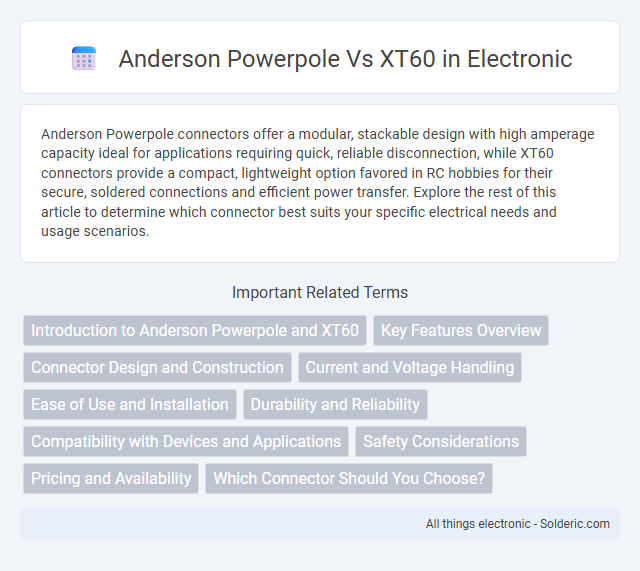Anderson Powerpole connectors offer a modular, stackable design with high amperage capacity ideal for applications requiring quick, reliable disconnection, while XT60 connectors provide a compact, lightweight option favored in RC hobbies for their secure, soldered connections and efficient power transfer. Explore the rest of this article to determine which connector best suits your specific electrical needs and usage scenarios.
Comparison Table
| Feature | Anderson Powerpole | XT60 |
|---|---|---|
| Current Rating | Up to 45A continuous | Up to 60A continuous |
| Voltage Rating | 600V DC | 500V DC |
| Connector Type | Modular, genderless | Polarized, keyed |
| Contact Material | Silver-plated copper | Gold-plated brass |
| Ease of Use | Quick connect/disconnect, modular stacking | Secure, snap-fit |
| Common Applications | Amateur radio, RC, power distribution | RC batteries, drones, small electric devices |
| Durability | High mechanical robustness | Good, but less modular |
| Size & Weight | Bulkier, heavier | Smaller, lightweight |
| Price | Moderate | Affordable |
Introduction to Anderson Powerpole and XT60
Anderson Powerpole connectors are widely recognized for their modular design, high current capacity, and durability in radio, automotive, and robotics applications. XT60 connectors, on the other hand, are popular for their secure locking mechanism and efficient power transfer primarily in RC hobbyist and drone batteries. Your choice between Anderson Powerpole and XT60 depends on the specific requirements of current handling, ease of connection, and application environment.
Key Features Overview
Anderson Powerpole connectors feature modular, genderless design with high-current capacity up to 45 amps, making them ideal for DC power applications and easy to interlock in versatile configurations. XT60 connectors deliver a secure, polarized connection rated for 60 amps continuous current, commonly used in RC batteries and drones due to their reliable, heat-resistant nylon housing. Both connectors offer low resistance and durability but differ in form factor and industry preference, with Powerpole favored for flexible, expandable power connections and XT60 for fixed, high-current battery interfaces.
Connector Design and Construction
Anderson Powerpole connectors feature a modular, genderless design with heavy-duty, gold-plated copper contacts enclosed in a durable polycarbonate housing, enabling easy stacking and secure, high-current connections up to 45 amps. XT60 connectors use a polarized, molded nylon housing with gold-plated bullet terminals designed to support continuous currents up to 60 amps while preventing reverse polarity connections. The Powerpole's versatile, compact design favors modular wiring setups, whereas the XT60's robust construction is optimized for high-current applications in RC and drone electronics.
Current and Voltage Handling
Anderson Powerpole connectors typically handle currents up to 45 amps and voltages of 600 volts DC, making them suitable for high-power applications and reliable electrical connections. XT60 connectors are rated for continuous currents up to 60 amps and voltages of 500 volts DC, favored in hobbyist and drone setups for their secure fit and thermal stability. Choosing between these connectors depends on your specific current draw and voltage requirements, with Powerpole excelling in versatility and XT60 in higher current handling for compact systems.
Ease of Use and Installation
Anderson Powerpole connectors offer a modular design that allows for quick, tool-free assembly and ensures reliable polarity alignment, making them highly user-friendly for various power applications. XT60 connectors require soldering during installation, which may demand additional tools and skills, potentially complicating the setup process for beginners. Your choice between these connectors should consider ease of installation and whether you prefer a solderless solution or a more secure, permanent connection.
Durability and Reliability
Anderson Powerpole connectors are known for their exceptional durability, featuring a robust, modular design that withstands high current loads and frequent connect/disconnect cycles without degradation. XT60 connectors offer reliable performance with a secure, vibration-resistant fit and high-quality nylon construction, ensuring stable connections under typical RC and drone applications. Your choice should consider the Powerpole's superior endurance in demanding, repetitive use scenarios versus the XT60's solid reliability in moderate load environments.
Compatibility with Devices and Applications
Anderson Powerpole connectors offer versatile compatibility for a wide range of devices, especially in amateur radio, solar power systems, and high-current DC applications, thanks to their modular design and scalability. XT60 connectors excel in applications requiring secure, high-current connections, such as drones, RC vehicles, and lithium polymer battery packs, ensuring reliable performance under demanding conditions. Your choice depends on device requirements; Anderson Powerpoles suit adaptable setups with varying amperage, while XT60s provide a robust solution for consistent, specialized high-current use.
Safety Considerations
Anderson Powerpole connectors provide a secure, genderless design that minimizes the risk of reverse polarity and accidental short circuits, making them safer for high-current applications. XT60 connectors feature tight-fitting connectors with gold-plated contacts that resist heat and oxidation, reducing the chances of electrical failure or fire hazards during use. When selecting between these connectors, your priority should be the specific voltage and current requirements to ensure optimal safety for your electrical setup.
Pricing and Availability
Anderson Powerpole connectors offer a cost-effective solution with widespread availability across electronics and amateur radio suppliers, often priced lower than XT60 connectors. XT60 connectors, favored in the RC and drone communities, typically come at a slightly higher price due to their specialized design and robust performance. Your choice depends on budget constraints and the specific availability within your local or online marketplace.
Which Connector Should You Choose?
When deciding between Anderson Powerpole and XT60 connectors, consider your application's current rating and ease of use; Anderson Powerpole connectors are modular and commonly used for higher current applications up to 45A, making them ideal for power distribution and amateur radio setups. XT60 connectors are compact, easy to solder, and rated for 60A continuous current, often preferred in RC vehicles and drones for secure, vibration-resistant connections. Your choice should reflect the specific power requirements and mechanical environment to ensure reliable, efficient connectivity.
Anderson Powerpole vs XT60 Infographic

 solderic.com
solderic.com